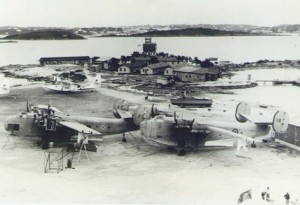Bermuda War Victim Mystery Solved
 A chance meeting in a churchyard helped a British military historian solve a mystery — and restore the grave of a war victim killed in Bermuda.
A chance meeting in a churchyard helped a British military historian solve a mystery — and restore the grave of a war victim killed in Bermuda.
Ken Porter recently bumped into a man with camera and clipboard wandering around the graves at St. Nicholas’ Church, Laindon near Basildon in the UK.
“I asked him what he was doing and it tuned out he was Steve Boreenatra who researches war graves and private memorials,” Mr. Porter, who is also a warden at the church, told the Basildon Yellow Advertiser today (Dec 9).
“I was able to show him a memorial I found, which just read ‘In Memory of Gerald. Pilot Fleet Air Arm, Killed in Bermuda June 1941’.”
Mr. Boreenatra was back the same day with the information Mr. Porter wanted –- it tuned out the Royal Navy pilot was the son of a couple, William and Louise Fynn, who ran a grocery shop in the village many years ago.
“I established he and his parents were buried at St Nicholas, so I searched for his grave,” Mr. Porter said.
It turned out the airman’s grave was across the path from the family memorial stone, which must have become dislodged.
“Now the grave and stone are back together and I have tidied it up,” Mr. Porter continued. “It was a lucky meeting I had.”
Bermuda was a forming-up point during World War Two (1939-45) for convoys numbering hundreds of ships. Despite the importance of guarding against Axis submarines and surface raiders operating in the area, the Royal Air Force did not post a Coastal Command detachment here to maintain air cover.
Instead, the Royal Navy’s Fleet Air Arm operated ad-hoc patrols from HMS “Malabar” on Boaz Island. This was a repair facility which had several aeroplanes on hand, but no aircrew. It operated its patrols using pilots from ships at the Dockyard on Ireland Island and RAF pilots posted at the RAF Ferry Command station on Darrell’s Island (pictured). These patrols ceased with the arrival of a US Navy patrol squadron, which operated from Darrell’s Island until Kindley Field became operational.

